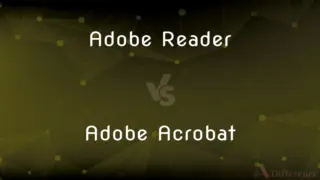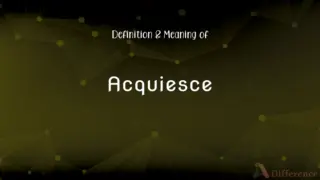Tub vs. Container — What's the Difference?
By Maham Liaqat & Urooj Arif — Updated on April 3, 2024
A tub is typically a wide, open, deep vessel, often used for bathing or washing, while a container is any receptacle used to hold, store, or transport items.

Difference Between Tub and Container
Table of Contents
ADVERTISEMENT
Key Differences
Tubs are characterized by their open, deep shapes, making them ideal for holding liquids or large quantities of items for bathing, washing, or storage purposes. Containers, on the other hand, come in a vast array of sizes, shapes, and materials, designed to hold, store, or transport various types of contents.
The key feature of a tub is its capacity to hold substantial volumes, often supported by its sturdy, durable design to accommodate the weight and pressure of the contents, especially when filled with water. The primary purpose of a container is to protect its contents and provide a means to organize, store, and transport goods efficiently.
In terms of mobility, tubs are usually stationary or have limited portability due to their size and the nature of their typical use cases, such as bathing. Containers, especially smaller ones, are designed to be more mobile, often featuring handles, lids, and lightweight materials that make them easy to move and transport.
Material choice is another area where tubs and containers differ significantly. Tubs are often made of durable materials like ceramic, metal, or heavy-duty plastic to withstand the weight of liquids or other heavy contents. Containers can be made from a wider range of materials, including glass, metal, plastic, or cardboard, depending on their intended use and the need for durability, weight, and environmental resistance.
Comparison Chart
Primary Use
Holding liquids or washing
Storing or transporting various items
ADVERTISEMENT
Design
Open, deep
Varies; often sealed and portable
Material
Durable materials like ceramic, metal
Range of materials, including glass, metal, plastic
Mobility
Stationary or limited
Often designed for easy transport
Functionality
Suited for specific tasks (e.g., bathing)
Versatile for a broad range of uses
Compare with Definitions
Tub
Wide container used for mixing or storing.
The contractor used a tub to mix the cement.
Container
Receptacle for holding or transporting items.
She packed her lunch in a small plastic container.
Tub
Container for plants or storage.
They used old tubs to plant tomatoes in their garden.
Container
Large metal box for shipping goods.
The goods were shipped overseas in a container.
Tub
Deep, open vessel for liquids.
She filled the tub with warm water for a bath.
Container
Box or case for organizing items.
She bought several containers to organize her crafting supplies.
Tub
Large basin used in laundry.
He soaked the stained clothes in the laundry tub overnight.
Container
Sealed unit for storing food.
Leftovers were kept fresh in an airtight container.
Tub
Informal for a bathtub.
The new apartment has a spacious tub in the bathroom.
Container
Any item that can contain something else.
He used a glass container to store the coffee beans.
Tub
A wide, open, deep, typically round container with a flat bottom used for holding liquids, growing plants, etc.
A rainwater tub
Container
A container is any receptacle or enclosure for holding a product used in storage, packaging, and transportation, including shipping. Things kept inside of a container are protected by being inside of its structure.
Tub
A short, broad boat that handles awkwardly
The old tub's in need of a refit
Container
An object for holding or transporting something
The cakes will keep for up to two weeks if kept in an airtight container
Tub
Plant in a tub
Tubbed fruit trees
Container
A receptacle, such as a carton, can, or jar, in which material is held or carried.
Tub
Wash or bathe in or as in a tub or bath
Even your formal evening gown can be tubbed
Container
A large reusable receptacle that can accommodate smaller cartons or cases in a single shipment, designed for efficient handling of cargo.
Tub
An open, flat-bottomed vessel, usually round and typically wider than it is deep, used for washing, packing, or storing.
Container
Someone who contains; something that contains.
Tub
The amount that such a vessel can hold.
Container
An item in which objects, materials or data can be stored or transported.
Tub
The contents of such a vessel.
Container
(transportation) A very large, typically metal, box used for transporting goods.
Tub
A bathtub.
Container
(by extension) Someone who holds people in their seats or in a (reasonably) calm state.
Tub
(Informal) A bath taken in a bathtub.
Container
(computing) A file format that can hold various types of data.
Tub
(Informal) A wide, clumsy, slow-moving boat.
Container
(object-oriented programming) An abstract data type whose instances are collections of other objects.
Tub
A bucket used for conveying ore or coal up a mine shaft.
Container
Any user interface component that can hold further (child) components.
Tub
A coal car used in a mine.
Container
(computing) A bundle consisting of operating system, application code and dependencies to be run sandboxed inside a virtualized environment; (by extension) the environment itself.
Tub
To pack or store in a tub.
Container
One who, or that which, contains; particularly, an artifactual object that is designed to contain some fluid or solid material, object or objects, especially for convenience in transporting the contained objects.
Tub
To wash or bathe in a tub.
Container
A large metallic box designed to hold many smaller boxes or packages, and used for convenience in loading and unloading large quantities of freight, such as on ships, trains, or airplanes.
Tub
To take a bath.
Container
Any object that can be used to hold things (especially a large metal boxlike object of standardized dimensions that can be loaded from one form of transport to another)
Tub
A flat-bottomed vessel, of width similar to or greater than its height, used for storing or packing things, or for washing things in.
He bought a tub of lard to roast the potatoes in.
Tub
The contents or capacity of such a vessel.
She added a tub of margarine to the stew.
Tub
A bathtub.
Tub
A slow-moving craft.
Tub
Any structure shaped like a tub, such as a certain old form of pulpit, a short broad boat, etc.
Tub
A small cask.
A tub of gin
Tub
Any of various historically designated quantities of goods to be sold by the tub (butter, oysters, etc).
Tub
(mining) A box or bucket in which coal or ore is sent up a shaft.
Tub
(obsolete) A sweating in a tub; a tub fast.
Tub
(slang) A corpulent or obese person.
Tub
(transitive) To plant, set, or store in a tub.
To tub a plant
Tub
(ambitransitive) To bathe in a tub.
Tub
An open wooden vessel formed with staves, bottom, and hoops; a kind of short cask, half barrel, or firkin, usually with but one head, - used for various purposes.
Tub
The amount which a tub contains, as a measure of quantity; as, a tub of butter; a tub of camphor, which is about 1 cwt., etc.
Tub
Any structure shaped like a tub: as, a certain old form of pulpit; a short, broad boat, etc., - often used jocosely or opprobriously.
All being took up and busied, some in pulpits and some in tubs, in the grand work of preaching and holding forth.
Tub
A sweating in a tub; a tub fast.
Tub
A small cask; as, a tub of gin.
Tub
A box or bucket in which coal or ore is sent up a shaft; - so called by miners.
Tub
To plant or set in a tub; as, to tub a plant.
Tub
To make use of a bathing tub; to lie or be in a bath; to bathe.
Don't we all tub in England ?
Tub
A relatively large open container that you fill with water and use to wash the body
Tub
A large open vessel for holding or storing liquids
Tub
The amount that a tub will hold;
A tub of water
Common Curiosities
Are tubs portable?
Tubs are generally not portable due to their size and the nature of their use, although smaller tubs can be moved more easily.
What types of materials are containers made from?
Containers are made from a variety of materials, including glass, metal, plastic, and cardboard, depending on their intended use.
Can a container be used for liquids?
Yes, a container can be used for liquids, especially if it is designed to be leak-proof and sealed.
What differentiates a container for shipping?
Containers for shipping are typically large, durable, and designed to be stackable and weather-resistant for safe transport of goods over long distances.
Is it common to reuse containers for different purposes?
Yes, it is common to reuse containers for various purposes, especially those made of durable materials like glass or plastic.
Can a tub be considered a container?
A tub can be considered a type of container, specifically one that is open and deep, primarily used for holding liquids or large quantities.
How are containers sealed?
Containers can be sealed with lids, caps, or other mechanisms that prevent the contents from spilling or being exposed to air or contaminants.
How do environmental considerations affect the choice of containers?
Environmental considerations can influence the choice of containers, with a preference for reusable, recyclable, or biodegradable materials to reduce waste.
What is the significance of container size?
The size of the container is significant as it must be appropriate for the volume and type of items it is intended to hold or transport.
What is the primary purpose of a tub?
The primary purpose of a tub is for holding liquids, particularly for bathing or washing.
Are all tubs made of heavy-duty materials?
While many tubs are made of heavy-duty materials like ceramic or metal, some are made of heavy-duty plastic or other materials suited for specific uses.
Can the design of a tub affect its functionality?
Yes, the design of a tub, including its depth and shape, can affect its functionality, especially in terms of how well it holds liquids or accommodates items for washing.
Can containers be used for storage?
Yes, containers are widely used for storage, providing a way to organize, protect, and maintain the condition of the items inside.
What innovations are influencing container designs?
Innovations in materials, sealing technologies, and environmental sustainability are influencing container designs to be more versatile, secure, and eco-friendly.
How do you choose the right container for a specific use?
Choosing the right container depends on the nature of the contents, the required level of protection, and the conditions under which it will be stored or transported.
Share Your Discovery

Previous Comparison
Postscript vs. Epilogue
Next Comparison
Upset vs. SadAuthor Spotlight
Written by
Maham LiaqatCo-written by
Urooj ArifUrooj is a skilled content writer at Ask Difference, known for her exceptional ability to simplify complex topics into engaging and informative content. With a passion for research and a flair for clear, concise writing, she consistently delivers articles that resonate with our diverse audience.












































